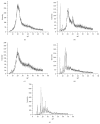Development, characterization, and in vitro biological performance of fluconazole-loaded microemulsions for the topical treatment of cutaneous leishmaniasis
- PMID: 25650054
- PMCID: PMC4306376
- DOI: 10.1155/2015/396894
Development, characterization, and in vitro biological performance of fluconazole-loaded microemulsions for the topical treatment of cutaneous leishmaniasis
Abstract
Cutaneous leishmaniasis (CL) is a resistant form of leishmaniasis that is caused by a parasite belonging to the genus Leishmania. FLU-loaded microemulsions (MEs) were developed by phase diagram for topical administration of fluconazole (FLU) as prominent alternative to combat CL. Three MEs called F1, F2, and F3 (F1-60% 50 M phosphate buffer at pH 7.4 (PB) as aqueous phase, 10% cholesterol (CHO) as oil phase, and 30% soy phosphatidylcholine/oil polyoxyl-60 hydrogenated castor oil/sodium oleate (3/8/6) (S) as surfactant; F2-50% PB, 10% CHO, and 40% S; F3-40% PB, 10% CHO, and 50 % S) were characterized by droplet size analysis, zeta potential analysis, X-ray diffraction, continuous flow, texture profile analysis, and in vitro bioadhesion. MEs presented pseudoplastic flow and thixotropy was dependent on surfactant concentration. Droplet size was not affected by FLU. FLU-loaded MEs improved the FLU safety profile that was evaluated using red cell haemolysis and in vitro cytotoxicity assays with J-774 mouse macrophages. FLU-unloaded MEs did not exhibit leishmanicidal activity that was performed using MTT colourimetric assays; however, FLU-loaded MEs exhibited activity. Therefore, these MEs have potential to modulate FLU action, being a promising platform for drug delivery systems to treat CL.
Figures






Similar articles
-
Enhancing the efficacy of fluconazole against Leishmania major: Formulation and evaluation of FLZ-nanoemulsions for topical delivery.Biomed Pharmacother. 2024 Sep;178:117109. doi: 10.1016/j.biopha.2024.117109. Epub 2024 Jul 17. Biomed Pharmacother. 2024. PMID: 39024835
-
Structural characterization and in vitro antioxidant activity of kojic dipalmitate loaded w/o/w multiple emulsions intended for skin disorders.Biomed Res Int. 2015;2015:304591. doi: 10.1155/2015/304591. Epub 2015 Feb 15. Biomed Res Int. 2015. PMID: 25785265 Free PMC article.
-
Oil-in-water lecithin-based microemulsions as a potential delivery system for amphotericin B.Colloids Surf B Biointerfaces. 2008 Oct 15;66(2):253-9. doi: 10.1016/j.colsurfb.2008.06.016. Epub 2008 Jul 4. Colloids Surf B Biointerfaces. 2008. PMID: 18676122
-
Current treatment for cutaneous leishmaniasis: a review.Am J Ther. 2009 Mar-Apr;16(2):178-82. doi: 10.1097/MJT.0b013e3181822e90. Am J Ther. 2009. PMID: 19300044 Review.
-
Topical Microemulsions: Skin Irritation Potential and Anti-Inflammatory Effects of Herbal Substances.Pharmaceuticals (Basel). 2023 Jul 13;16(7):999. doi: 10.3390/ph16070999. Pharmaceuticals (Basel). 2023. PMID: 37513911 Free PMC article. Review.
Cited by
-
Design and Characterization of Lipid-Surfactant-Based Systems for Enhancing Topical Anti-Inflammatory Activity of Ursolic Acid.Pharmaceutics. 2023 Jan 21;15(2):366. doi: 10.3390/pharmaceutics15020366. Pharmaceutics. 2023. PMID: 36839688 Free PMC article.
-
Potency and Preclinical Evidence of Synergy of Oral Azole Drugs and Miltefosine in an Ex Vivo Model of Leishmania (Viannia) panamensis Infection.Antimicrob Agents Chemother. 2022 Jan 18;66(1):e0142521. doi: 10.1128/AAC.01425-21. Epub 2021 Oct 25. Antimicrob Agents Chemother. 2022. PMID: 34694879 Free PMC article.
-
Lipid-Based Nanocarriers for Topical Therapy of Cutaneous Leishmaniasis: An Insight into the Mechanism of Action.ACS Omega. 2025 Jun 5;10(23):23873-23888. doi: 10.1021/acsomega.5c00046. eCollection 2025 Jun 17. ACS Omega. 2025. PMID: 40547705 Free PMC article. Review.
-
Silver-Nanoparticles Embedded Pyridine-Cholesterol Xerogels as Highly Efficient Catalysts for 4-Nitrophenol Reduction.Materials (Basel). 2020 Mar 25;13(7):1486. doi: 10.3390/ma13071486. Materials (Basel). 2020. PMID: 32218243 Free PMC article.
-
Peptide KSL-W-Loaded Mucoadhesive Liquid Crystalline Vehicle as an Alternative Treatment for Multispecies Oral Biofilm.Molecules. 2015 Dec 25;21(1):E37. doi: 10.3390/molecules21010037. Molecules. 2015. PMID: 26712726 Free PMC article.
References
-
- Reis S. R., Gomes L. H. M., Ferreira N. M., et al. Ocorrência de flebotomíneos (Diptera: Psychodidae: Phlebotominae) no ambiente peridomiciliar em área de foco de transmissão de leishmaniose tegumentar no município de Manaus, Amazonas. Acta Amazonica. 2013;43(1):121–123. doi: 10.1590/s0044-59672013000100016. - DOI
-
- Shaw J. J., Lainson R. Leishmaniasis in Brazil: X. Some observations on intradermal reactions to different trypanosomatid antigens of patients suffering from cutaneous and mucocutaneous leishmaniasis. Transactions of the Royal Society of Tropical Medicine and Hygiene. 1975;69(3):323–335. doi: 10.1016/0035-9203(75)90127-3. - DOI - PubMed
Publication types
MeSH terms
Substances
LinkOut - more resources
Full Text Sources
Other Literature Sources
Miscellaneous

